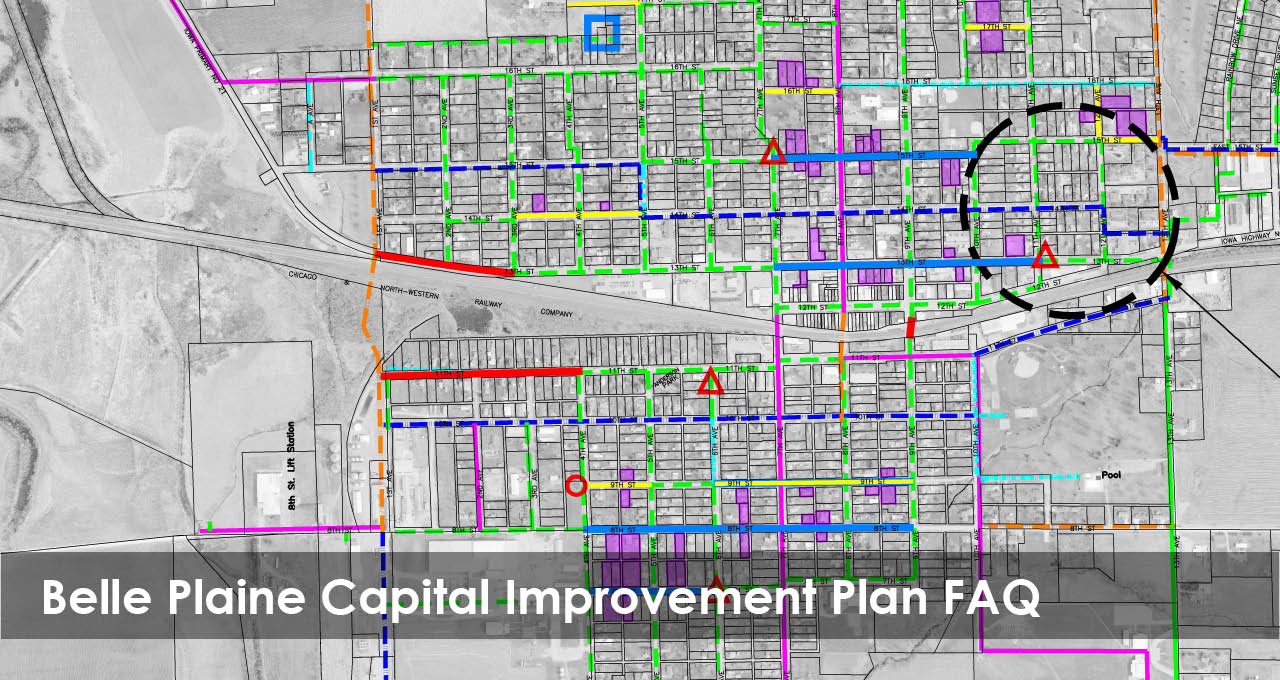City of Belle Plaine: Capital Improvement FAQ

Project Overview:
The City of Belle Plaine has hired Anderson Bogert Engineers and Surveyors to develop a Capital Improvement Program for city-owned water and sanitary sewer facilities. The Anderson Bogert engineering team is working with the city officials to develop a multi-year plan that will identify facilities that are in need of replacement or repair. Once target facilities are identified, maintenance priorities will be set and an initial cost estimate will be determined for each segment.
Public Input:
You can play an important role in setting maintenance priorities for the city by filling out a survey at the following link: bit.ly/BellePlaineCIP
Frequently Asked Questions:
Why do segments of the sanitary sewer need to be maintained?
Maintenance is a normal part of both engineering and construction. It is particularly important in sanitary sewer systems because it can reduce the risk of sewer backups. Sewer backups are most commonly caused by structural failures (like collapsed pipes or service tap intrusions), debris building up in the system (like roots, grease, sediment, or paper products), or excess flow from groundwater or surface water entering the lines through inflow and infiltration (I&I).
What is inflow and infiltration (I&I), and why is it a problem?

Inflow typically occurs when rainwater enters the sanitary sewer system through direct connections such as roof downspouts, driveway drains, sump pumps, and cross connections with storm drains. Many such connections are illegal as they misdirect rainwater into the sanitary sewer and place stress on the system. This stress can cause manholes to overflow, basement sewers to back up, and often results in property damage during heavy rainfall or snow melt.
Infiltration occurs when groundwater seeps through holes, breaks, joint failures, or other indirect connections into the sanitary sewer system. While it is a less-severe problem than inflow, over time, infiltration can heavily damage the City’s sewers.
How are inflow and infiltration (I&I) issues determined?
In order to identify and locate potential I&I issues we recommend several investigative techniques. While the actual techniques will vary the most common methods include:
- Televising Sewer Lines: a remote-operated camera is lowered into a sewer line through a manhole. A nearby crew operates the camera and collects visual feedback that is used to assess the integrity of the line and identify potential concerns.
- Sanitary Sewer “Smoke” Testing: a harmless combination of “smoke” and air is pumped into the sewer line. A field crew monitors the location of any smoke that escapes the system through compromised sewer lines and records the information for further investigation.
- Manhole Investigation: a comprehensive investigation is performed on site by qualified personal. The investigation crew will access the manhole and conduct a visual inspection of the accessible sewer line.
Why does the City’s water system need to be maintained?
The continued functionality of the City’s water system depends on adequate maintenance. Routine maintenance will help preserve the integrity of the water system and reduce the likelihood of breaks in the water main. Additionally, the inspection and maintenance of city fire hydrants and water main valves will ensure that these facilities are in working order in the event of an emergency. A properly maintained water system promotes greater health and safety among the residents of the city.
What improvements are planned for the City’s water system?
Improvements to the City of Belle Plaine’s water system will focus on the following key areas: water main reconstruction, water main valve replacement, and fire hydrant replacement. These improvements were selected based on the City’s present needs and their future benefit to residents.
-

Fire hydrant image courtesy of 玄史生 through Wikimedia Commons Water main reconstruction: as water main lines age, they occasionally break. When such breaks occur, it is Public Works’ top priority to stop water loss and restore service to residents as quickly as possible. Once the immediate needs of the residents are met, reconstruction of the broken main is required. The City has identified multiple instances where reconstruction will be necessary. For more information on the planned reconstruction of select water mains, please contact us.
- Water main valve replacement: to protect the integrity of the water system, water main valves need to be regularly replaced. Replacements will occur incrementally over the next few years.
- Fire hydrant replacement: much like water main valves, fire hydrants needs to be replaced periodically in order to ensure their continued functionality. Fire hydrant replacements will take place systematically over the next few years.
What costs are associated with the Belle Plaine Capital Improvement Program?
The present focus of this project is to identify and evaluate current problems within the City’s sanitary sewer & water mains. As these problems are identified, their severity and potential cost are evaluated. Once all of the necessary information is collected, our design team will work with the City to compile cost estimates for the needed repairs. As estimates are completed, funding options will be explored.
When will the Capital Improvement Projects be completed?
The Capital Improvement Program has both short-term and long-term elements. The City has set the investigation and assessment of potential problems as its first priority. After the first phase of the program, the City will develop a timeline based on the severity of identified problems and the cost associated with necessary replacement/repairs. Additional information will be made public as it becomes available.
Anderson Bogert believes in sustainable design. We work with stakeholders on every step of a project in order to create a safe and visibly pleasing final product.
If you have input on this, or any of our other projects, we would love to hear from you. To speak with a member of our design team, call us at (319) 377-4629 or visit our contact page.



